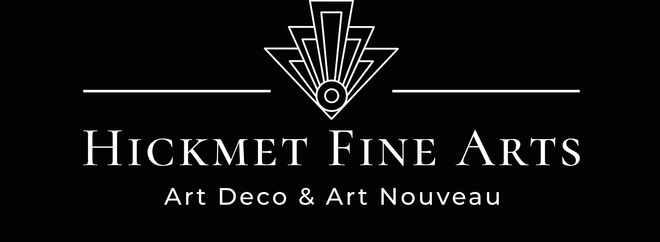lA fabulous limited edition Art Deco bronze of a beautiful young woman in diaphanous dress cold painted with enamel colour and with bright gilded highlights wearing a spectacular headdress of circular form representing the sun, with hanging appendages. The figure raised on an integral stepped plinth. Signed Erté,, dated 1980, numbered 223/300 with RKP Int foundry mark.
Sorry, this item has been sold. If you would like information about similar items please contact us on 07971850405 or make an enquiry via email
ADDITIONAL INFORMATION
Height: 44 cm
Circa: 1980
Foundry: RKP Int
Materials: Bronze
Book Ref: Erté Sculpture by Erté
Page No: Front Cover, 52
SKU: 8271
ABOUT
Erté Sculpture
Erté le Soleil – A costume for a fancy-dress ball inspired this sculpture. The design was published in Harper's bazaar in 1921. The woman's beautiful headdress represents a huge sun with shimmering gold beads; her skirt is held by the beak of a fantastic bird. The twenties was the era of a new sun worship, and also of beautiful and fantastic fancy-dress balls. Many balls were based on a theme- such as the Ball of Precious Stones- or on a combination of colours.
Erté: Process of producing a bronze
First, the artist models the sculpture in clay. A plaster mold of the model is made, from which a plaster cast is produced and the details are refined. After the plaster cast has been carefully checked to be sure that it is accurate, and final changes have been made, a flexible rubber mold is made from the plaster. This mold enables every detail to be captured. Molten wax is poured into the rubber mold, producing a faithful wax casting of the sculpture. This casting is then checked for detail and cleaned up, following which the wax cast is dipped into a bath of liquid ceramic to produce another mold. After several days, when the ceramic mold is dry, it is heated to melt the wax, which runs out through openings in the mold, leaving a cavity in its place (Hence the term lost wax). The mold is then fired in a kiln to bake the ceramic to a high degree of hardness. The final casting made by pour molten bronze into the cavity. When the bronze has cooled, the ceramic mould is carefully broken away, revealing the bronze sculpture within. Then the piece is sandblasted and chased to clean it up and removed imperfections. Finally, the sculpture is treated with chemicals and heat to achieve the desired patinas.
Erté’s words
” In fashion- creating forms for living people-in the design of furniture, in the design of theatrical settings and costumes, in the design of jewellery, one is functioning in three dimensions, and all this work in the round can be considered sculptural. In this sense, my theatrical settings are large environmental sculptures. I have never made a drawing for a dress or a costume without first having a fully developed idea of it in the round. In fact, before I start a design every detail has to be ripe in my mind, and I execute it without any deviation,because the conception has become a living reality deep in my creative psyche. When I design an evening dress, for example, I assemble a woman in full costume inside my head, swirling in her gown, showing every fold, seam and hem.”
To view our selection of Erté figures like the Erte Amazon please click here.













